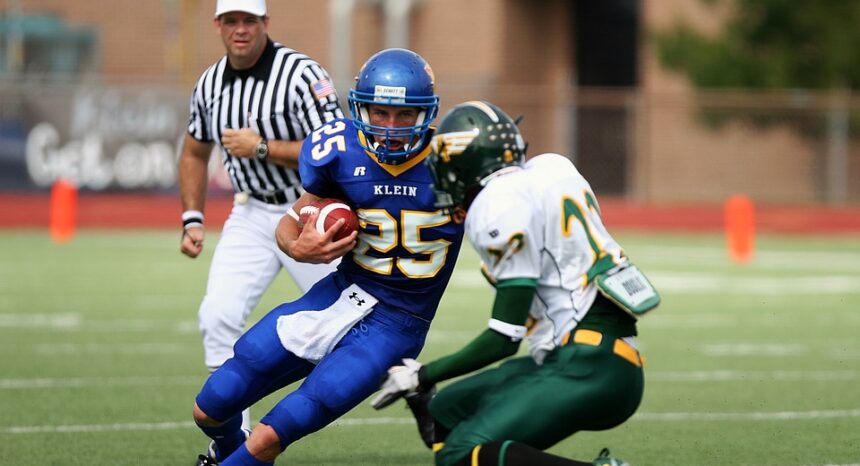Athletics are a key feature of the high-school experience for most American youth, whether they are athletes or spectators. As of 2009, 38% of high-school seniors were involved in team sports, according to the U.S. Department of Education. The National Federation of State High School Associations announced in late 2014 that sports participation reached a record high of 7.8 million high-school students for the 2013-14 academic year.
While high-school athletics continue to be one of the most popular extracurricular activities for today’s teens, public school districts sometimes struggle to fund such programs. In School Board meetings and government gathering spaces across the country, educators, community leaders and others have debated the benefits and consequences of school-sponsored sports, which often must compete against academic programs for at least a portion of their funding. In recent years, some school districts wrestling with budget constraints have cut back on their sports programs or considered eliminating them completely. Meanwhile, numerous academic studies have explored the issue of student physical activity more broadly, including its effect on children’s mental health and academic outcomes. A 2012 report published in the Journal of the American Medical Association, Pediatrics offers a review of 14 studies related to student physical activity and concludes that there is a positive relationship between physical activity and academic performance.
A 2015 report published in the Journal of Leadership and Organizational Studies, “Sports at Work: Anticipated and Persistent Correlates of Participation in High School Athletics,” adds new insights into this issue. Authors Kevin M. Kniffin and Brian Wansink of Cornell University and Mitsuru Shimizu of Southern Illinois University completed two complementary studies to try to gauge whether former student-athletes make better employees. For the first study, 66 adults were asked questions about how they perceive people who participated in different extracurricular activities while in high school. The second study used data from the 2000 University of Illinois Veterans Survey, which collected a variety of information from 931 World War II veterans, to determine how participation in youth sports may have influenced these veterans’ career paths, leadership skills and the likelihood that they volunteer and donate to charity.
Key findings of the first study include:
- People tend to expect former student-athletes to display higher levels of leadership, self-confidence and self-respect than former students who participated in the school band or school yearbook club during high school.
- People tend to expect former student-athletes to be less generous in terms of doing volunteer work and donating to charity when compared to former students who had been involved with the school band or the school yearbook.
- There were no significant differences in how study participants perceived the time management skills of former students who had been involved in sports, the school band or school yearbook.
Key findings of the second study include:
- Of the veterans who were surveyed, those who played at least one varsity sport in high school tended to rate higher scores in categories related to leadership, self-confidence and self-respect than those who did not.
- Former student-athletes were more likely to report that they do volunteer work and donate money to various organizations more than 55 years after graduating high school.
- A larger proportion of former student-athletes reported having had careers in “upper management.”
This report builds on prior research and suggests that participating in youth sports might influence the development of certain desirable skills and values. The authors recommend that questions about participation in youth sports be included in job interviews — even for candidates who are relatively far removed from high school — as such participation might have important implications for a person’s leadership capacity and other personality traits. The authors caution, however, that former athletes might be preferred for these reasons even though such qualities might not be necessary for the job in question. The study highlights the need for closer attention to the relevance of sports in the workplace and the activities of older populations. “Our studies address a surprising dearth of systematic study on the relevance of participation in youth sports for early-career selection preferences as well as late-in-life leadership, personality, and behavior,” the authors state. “Given the popular importance of sports in many people’s lives, closer attention is overdue for understanding sports’ roles in the workplace and beyond — including late-in-life charitable giving and voluntarism.”
Related research: A July 2015 report in the Journal of Adolescent Health, “High School Sports Involvement Diminishes the Association Between Childhood Conduct Disorder and Adult Antisocial Behavior,” indicates that participating in high school sports may help disrupt antisocial behavior that begins in childhood and adolescence. An April 2015 report in Global Pediatric Health, “Reported Sports Participation, Race, Sex, Ethnicity, and Obesity in U.S. Adolescents From NHANES Physical Activity,” explores the relationship between participation in different types of athletic activities and adolescent obesity. A 2013 report in the Journal of Pediatrics, “Incidence of Sports-Related Concussion among Youth Football Players Aged 8-12 Years,” looks at the prevalence and causes of medically-diagnosed concussions among male football players in western Pennsylvania during the 2011 youth football season.
Keywords: sports, athletics, education, achievement, sports and academics, youth sports, youth athletics, student athletes, obesity, competitive sports, football


Expert Commentary